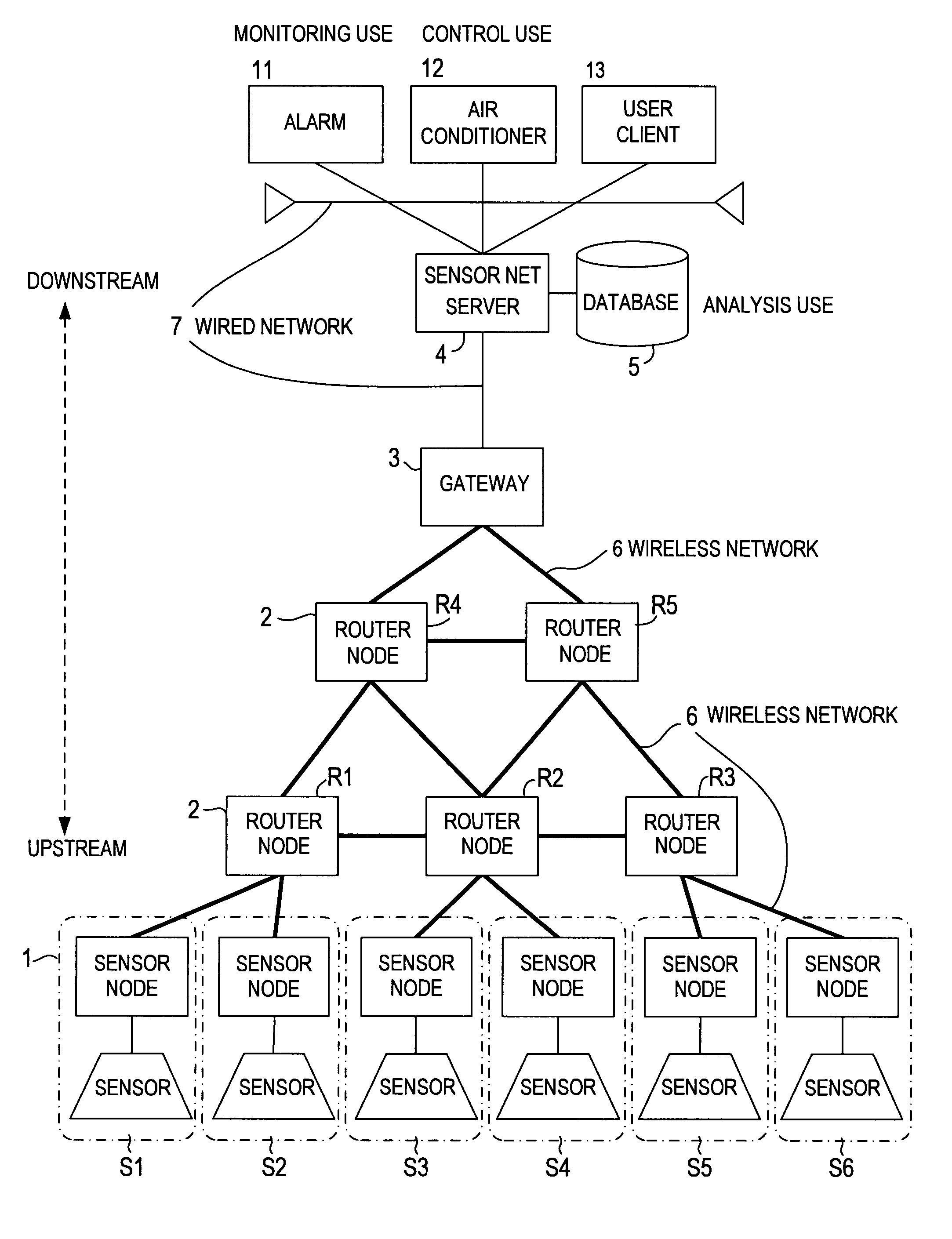Sensor network system and data processing method for sensor network
a sensor network and data processing technology, applied in data switching networks, instruments, frequency-division multiplexes, etc., can solve problems such as system shutdown, communication failure, communication overload, etc., and achieve the effect of ensuring the reliability of the sensor network system
- Summary
- Abstract
- Description
- Claims
- Application Information
AI Technical Summary
Benefits of technology
Problems solved by technology
Method used
Image
Examples
first embodiment
[0063]FIG. 1 is a block diagram showing an example of a sensor network system (hereinafter referred to as sensor net system) to which this invention is applied.
[0064]The sensor net system observes environmental information through sensors in many sensor nodes 1 dispersed throughout an environment. The observation information is delivered to a sensor net server 4 via router nodes 2 and a gateway 3 which are connected by a wireless network 6. The sensor net system thus collects observation information to the sensor net server 4 to serve as a computer system that assists a user in making a decision or the like. The sensor net server 4 has a database 5 which stores collected observation information.
[0065]Each sensor node 1 has a sensor such as a temperature sensor or a humidity sensor and an identifier for identifying an individual (person or subject), and is connected to one router node 2 via the wireless network 6. Each router node 2 has multiple sensor nodes 1 connected thereto, and ...
second embodiment
[0354]FIG. 39 shows a second embodiment of this invention. Unlike the first embodiment where a deceleration node and a deceleration processing executing node are determined after an excess transmission rate node is identified, the second embodiment omits identification of an excess transmission rate node in executing deceleration processing. The rest of the configuration of the second embodiment is the same as the first embodiment.
[0355]Shown in FIG. 39 is an example of deceleration processing of a sensor net system to which the second embodiment is applied. In FIG. 39, the sensor nodes S1 to S8, the router nodes R1 to R8, and the gateway GW are arranged in the same way as in FIG. 16 of the first embodiment.
[0356]In the example of FIG. 39, the sensor nodes S3, S5, and S6 are excess transmission rate nodes whose data transfer amount per unit time has increased to an excessive level. The router node R7 is a boundary node since the sum of the inflow velocity of the router nodes R5 and ...
third embodiment
[0390]FIGS. 46 and 47 show a sensor net system according to a third embodiment of this invention which has more than one gateway 3 and sensor net server 4 described in the first embodiment. The third embodiment shows an example in which the deceleration processing between router nodes described in the first embodiment is applied to event transfer between servers.
[0391]A personal area network (PAN) 60 constituted of the sensor node 1, the router node 2, and the wireless network 6 which are described in the first embodiment with reference to FIG. 1 is connected upstream to each gateway 3. Events from the sensor node 1 are transferred downstream to the gateway 3 by the PAN 60.
[0392]The sensor net server 4, which collects events transferred from the upstream, is connected downstream to each gateway 3 via the wired network 7.
[0393]A host server 41, which utilizes events collected by the sensor net server 4, is connected downstream to the sensor net server 4 via the wired network 7. The h...
PUM
 Login to View More
Login to View More Abstract
Description
Claims
Application Information
 Login to View More
Login to View More - R&D
- Intellectual Property
- Life Sciences
- Materials
- Tech Scout
- Unparalleled Data Quality
- Higher Quality Content
- 60% Fewer Hallucinations
Browse by: Latest US Patents, China's latest patents, Technical Efficacy Thesaurus, Application Domain, Technology Topic, Popular Technical Reports.
© 2025 PatSnap. All rights reserved.Legal|Privacy policy|Modern Slavery Act Transparency Statement|Sitemap|About US| Contact US: help@patsnap.com



